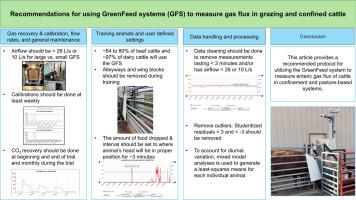Experimental and experiential recommendations for using the GreenFeed systems to measure gas flux in grazing and confined cattle
IF 1.9
Q2 MULTIDISCIPLINARY SCIENCES
引用次数: 0
Abstract
Improving ruminant production efficiency is contingent on accurately measuring gas fluxes from individual animals in grazing and confined feeding environments The GreenFeed system (GFS) has been increasingly utilized by researchers to measure gas flux of ruminants in their production environment. However, there are wide inconsistencies in methodologies from laboratory-to-laboratory. The objective of this manuscript is to provide standardized recommendations for measuring individual animal gas fluxes of methane, carbon dioxide, oxygen, and hydrogen by the GFS, which are based on experiential and experimental evidence. The method includes:
- •GFS management: Setup, maintenance, and calibration of sensors
- •Animal Recommendations: Number of animals to sample, training on use of the system, and bait feeds – including type, composition, and mass. Further, we address operational considerations of using the GFS in extensive grazing environments and confined feeding operations.
- •Data recommendations: pre-processing data, data cleaning, handling outliers, approaches for estimating individual animal gas fluxes, and uses of application performance interfaces in conjunction with R for statistical analyses.

使用GreenFeed系统测量放牧和圈养牛的气体通量的实验和经验建议
提高反刍动物的生产效率取决于在放牧和密闭饲养环境中准确测量动物个体的气体通量,研究人员越来越多地利用GreenFeed系统(GFS)来测量反刍动物在其生产环境中的气体通量。然而,各个实验室之间的方法存在广泛的不一致。本手稿的目的是提供标准化的建议,测量单个动物气体通量的甲烷,二氧化碳,氧气和氢气的GFS,这是基于经验和实验证据。该方法包括:•GFS管理:传感器的设置、维护和校准•动物推荐:要取样的动物数量、系统使用培训和饵料饲料-包括类型、组成和质量。此外,我们还讨论了在广泛放牧环境和有限饲养操作中使用GFS的操作考虑因素。•数据建议:预处理数据,数据清洗,处理异常值,估计单个动物气体通量的方法,以及与R一起使用应用程序性能接口进行统计分析。迫切需要增加跨实验和试验组的GFS管理的标准化。我们希望这些基于我们的集体经验和实验证据的建议将有助于GFS方法的标准化。
本文章由计算机程序翻译,如有差异,请以英文原文为准。
求助全文
约1分钟内获得全文
求助全文
来源期刊

MethodsX
Health Professions-Medical Laboratory Technology
CiteScore
3.60
自引率
5.30%
发文量
314
审稿时长
7 weeks
期刊介绍:
 求助内容:
求助内容: 应助结果提醒方式:
应助结果提醒方式:


